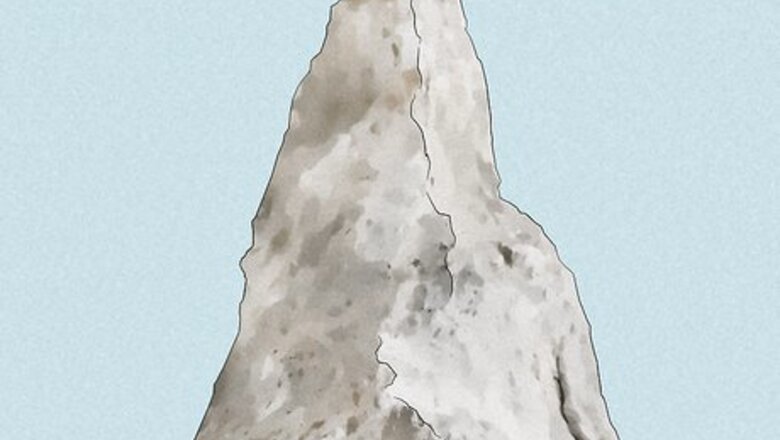
views
- Choose a 15-25 lb (6.8-11.3 kg) slab of soft stone like soapstone or alabaster. Avoid hard stones like granite or marble since these require special tools to carve.
- Wear goggles, an N95, and gloves, and work in an outdoor space to avoid breathing in dust. Place your stone on a sandbag to keep it steady as you carve.
- Use a hammer and chisel to chip at the stone. Chisel in the same direction as the grain of the stone, then use a file to smooth out your finished sculpture.
Choosing the Right Stone
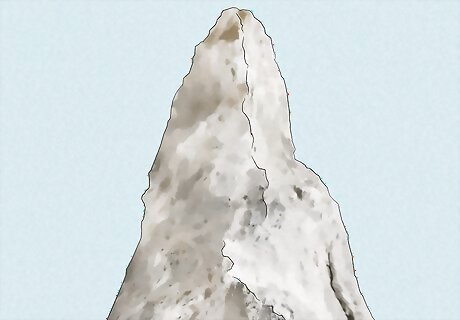
Choose soapstone if you’re a beginner and have few tools for carving. Soapstone is extremely easy to carve. It has the texture of a dry bar of soap and can be shaped with very little force. Use soapstone if you are making a small sculpture that won't be easily damaged if you accidentally scratch or nudge it. Soapstone is soft enough to carve with your fingernails, or with harder rocks taken from your yard. It also comes in many colors like grey, green, and black. Buy a soapstone block on Amazon for $60-90, or check a local stone carving supply shop. Some soapstone contains asbestos, which can be dangerous if inhaled. Wear an N95 mask when carving soapstone.
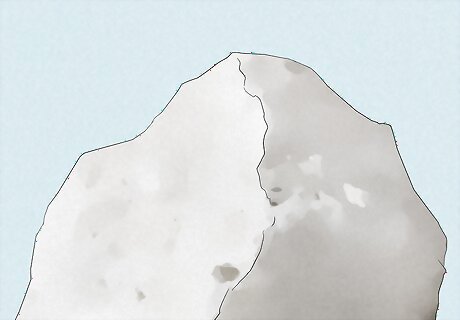
Buy alabaster for the best combination of durability and malleability. Alabaster is best if you want a colorful, sturdy sculpture. It comes in a variety of colors like white, gray, beige, orange, yellows, reds, and translucent. You can buy alabaster online or from a local art supplier. Although alabaster is generally harder than soapstone, it still carves easily. This makes it great for beginner sculptors since it retains its shape and doesn’t require specialized tools or strenuous effort. You can also use limestone since it carves easily and holds its shape. However, limestone only comes in shades of gray and tan.
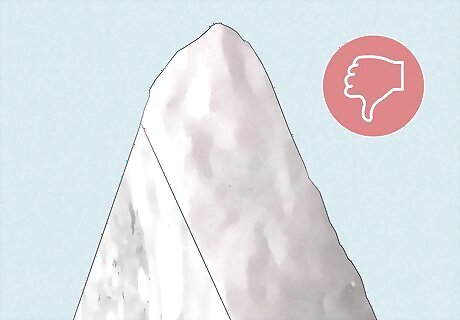
Avoid very hard stones like granite and marble. These are extremely hard and difficult to carve. You would need specialized tools to carve them. They also require strenuous effort and take a long time to carve. Granite and marble are usually sculpted in large quantities since they are most optimal for statues and other large items that require durability. Even experienced carvers might spend up to 80 hours working on a relatively simple piece made from granite or marble.
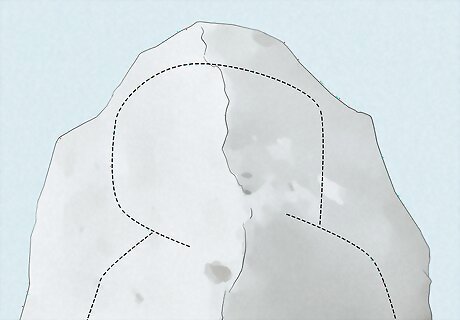
Pick a slab of stone that is much larger than your intended sculpture. Carving is a subtractive process, not an additive one. Unlike adding paint to a canvas, carving involves chipping away bits of stone until you’re left with a sculpture. Choose a 15-25 lb (6.8-11.3 kg) stone block for sculpting. Blocks smaller than 15 lbs will break if carved with a hammer and chisel, while sculptures made from larger blocks may take a long time to finish. Choose a 15 lb (6.8 kg) block for your first sculpture. Its smaller size will be easier to work with.
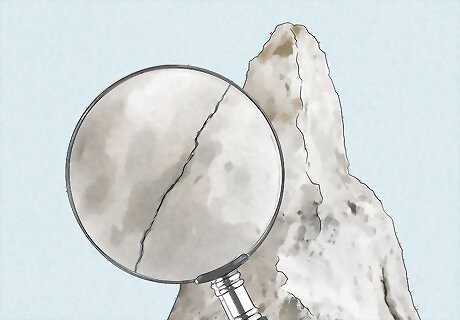
Inspect your stone for cracks and fissures. Use a spray bottle to wet the stone, since cracks and fissures are easier to see on wet rock. You will most likely see a few, but this is normal since stone is a natural material. Avoid using stone with cracks that wrap all the way around the rock. These types of cracks could cause the stone to break during the sculpting process. Tap larger stone blocks in different locations with a hammer or the back of a chisel. If the block makes a "ringing" sound, the stone is probably solid in that area and doesn’t have hidden cracks. If it makes a "thud" sound with no ring, there may be large cracks beneath the surface. Purchase your stone from a stone carving supplier, not a stone yard. If possible, ask an experienced carver or store employee to help you find a sturdy stone to work with.
Getting the Necessary Tools

Wear an N95 mask or full-face respirator while carving. Stone may contain asbestos or silica, which are harmful if inhaled. If possible, use an N95 or full-face respirator rated for asbestos. If you don’t have these, a standard N95 will still offer better protection than no mask at all. Wet the rock first before carving to reduce the amount of dust. Work in an outdoor environment like a yard or porch. Use a fan to blow away dust while you work.

Wear goggles to protect your eyes from stone chips. Tiny bits of material will fly off the stone as you sculpt it. These can get in your eyes and cause irritation or injury. To prevent this, always wear safety goggles when chiseling or sanding your stone. If you wear prescription glasses, place the goggles over your glasses. Keep a spare set of goggles nearby in case the ones you’re wearing get scratched.

Wear gloves to protect your hands. Stone is very abrasive and can cause blisters, scrapes, splinters, or cuts. Wear worker’s gloves while working with large blocks of stone. For medium or smaller blocks, you can use gardening gloves. Cut-resistant gloves can also prevent injuries from sharp tools.
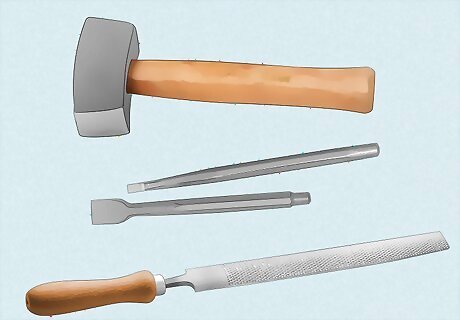
Purchase a carving hammer, chisel, and metal files. Choose a 1.5 - 2 lb (0.7 - 0.9 kg) double-sided carving hammer with wide, flat faces. Purchase a flat chisel with a simple, two-sided tip. Opt for a set of 3-4 metal files of different sizes made for carving stone. Buy a double-sided carving hammer for $7-25 from Amazon, or check your local hardware store. Find a stone chisel on Amazon for $12-26, or check a local hardware store or stone carving supplier. You can also purchase a toothed chisel to help with fine shaping your sculpture—buy one on Amazon for $15-30. Stone filing sets are available on Amazon for $8-20.

Buy a sandbag to support your stone block. Half-fill the sandbag with kitty litter instead of sand to reduce the weight. Tie the sandbag shut to keep the kitty litter from spilling out. In future steps, you’ll rest your stone block on the sandbag as you work on it. Purchase bags of cheap, low-quality kitty litter for your sandbag. Sand is heavy and tends to settle too easily to support your stone block. Don’t fill the bag more than halfway. The extra space will provide room for your sculpture to rest on it.
Carving Your Stone

Draw your design on a piece of paper. Make your first sculpture an abstract shape. Avoid making detailed pieces like human statues until you are more experienced. Visualize your piece as you draw. Although your drawing will be 2D, it will help you better visualize how your 3D item will need to be sculpted. You can also create a clay version of your sculpture to use as a reference. You can add and remove clay until your desired shape is achieved.

Examine the stone to determine the direction of the bed or grain. Stone has a “grain” similar to wood, called the “bed.” Note the direction of the bed. In future steps, be sure to break the stone in the direction of the bed whenever possible. This helps the pieces come off predictably, rather than in random sizes. Wet the stone to better see the bed lines. They’ll appear as distinctive color patterns flowing in the same direction.
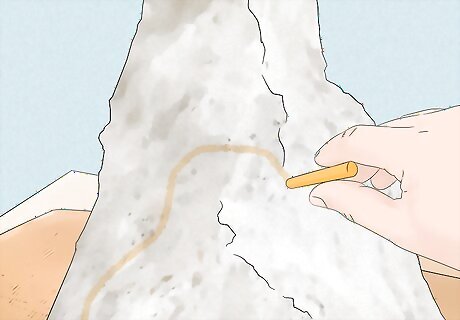
Use a crayon to draw your design on the stone. Mark your design on all sides of the stone. Be sure the height and width of the drawings are correct on all sides. You’ll use this crayon drawing as a blueprint while carving your stone. Avoid using pencils, pens, or markers on your stone. Pencil marks may be hard to see on stone, while ink from pens and markers may stain the stone permanently.

Hold the hammer in your dominant hand and the chisel in the other. Grasp the chisel at its midpoint, similar to how you would hold a microphone. Hold your chisel firmly and make sure it touches the stone at all times. Avoid letting your chisel bounce or jiggle, or your strikes will be inaccurate. Move your thumb to the side of the chisel where your other fingers are situated. This helps prevent you from striking your thumb with the hammer by accident. If carving along an edge, use a flat chisel instead of a toothed one. Having only some of your teeth on the rock while striking it can cause the teeth to break off, making your chisel useless and creating a potential hazard.
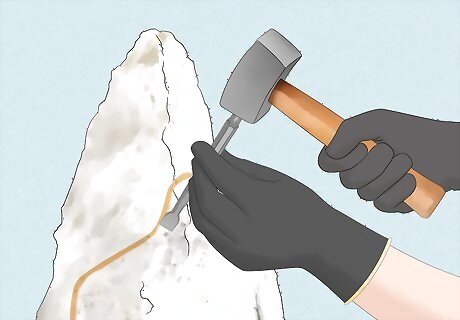
Strike the end of the chisel with your hammer. Hold your chisel at 45 degree angle or lower, relative to the rock’s surface. Tap the chisel repeatedly until chips of stone come off the rock. Avoid striking the stone head-on. A head-on strike will create a "stone bruise," causing the stone to turn white and creating a blemish on your final piece. If your chisel becomes embedded into the stone and does not produce stone chips, strike the stone at a shallower angle. Carving at too shallow an angle will cause your chisel to skip off the stone, removing nothing. To fix this, strike at a deeper angle or use the toothed chisel.
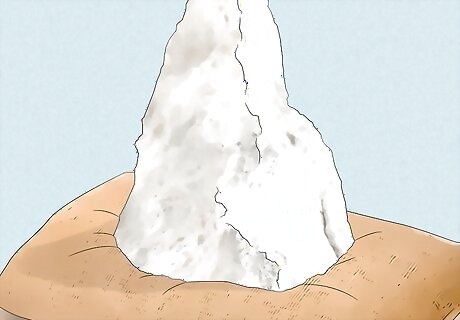
Place your stone on the sandbag to keep it steady. This will make it easier to carve your stone block since you won’t have to spend energy keeping it still. Readjust the stone’s position on the sandbag every few minutes to keep it centered. Carve standing up if possible. This makes it easier to angle your chisel down toward the floor, which maximizes each hammer blow and reduces the stone’s movement. If your stone still moves on the sandbag, lean the stone against your body while pushing it against you. Make sure the surface you’re carving is facing away from you. If carving on a folding table, place your sandbag and stone over the legs at one end.
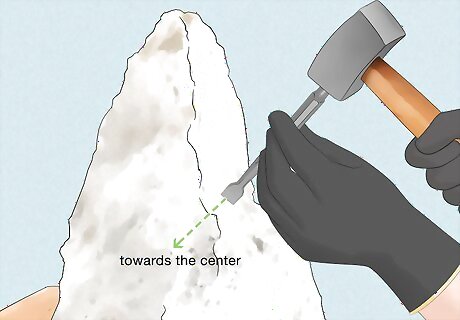
Carve toward the center of the stone, not toward the edges. This helps prevent the stone from breaking since the stone is thinner and more fragile around the edges. Carve with your chisel facing toward the center. When working on edges, carve down the length of the edge rather than striking perpendicular to it. Carving toward the edges can cause you to accidentally chip off too much stone. If you can’t avoid carving toward an edge, use slow, gentle hammer blows to prevent large chunks of stone from coming off.
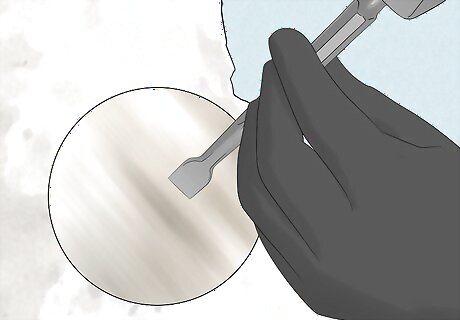
Chisel along cracks, not across them. Chisel along the direction of the cracks instead of at a right angle. To avoid flaking, file along cracks when putting the finishing touches on your stone. This will also help smooth out cracks and disguise them. All stone slabs have at least a few minor cracks. Reduce the amount of lost stone by working with the cracks, not against them.
Finishing Up
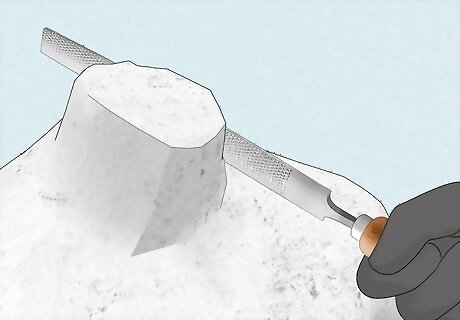
Use a file to put the finishing touches on your sculpture. File your stone away from you only. Push the file away from you, lift it up, return it to its original position, and push again. Do this repeatedly to create fine details, smooth out chisel marks, and refine the final shape of your piece. Use a straight steel file for soft rock like soapstone. For extremely detailed work, use Riffler files. Most stone carving files have unidirectional teeth, meaning that they only cut in one direction.
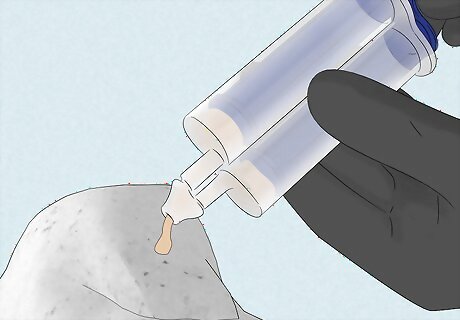
Use epoxy glue to reattach any pieces that came off accidentally. Do this for larger sculptures where losing a large piece of stone would ruin the design. For example, you could use epoxy glue to reattach the arm portion of a statue sculpture. For smaller sculptures, you may prefer to change your idea rather than glue pieces of stone. For example, you might opt to carve an arrow instead of a heart.

Sand your sculpture with 220 grit paper. This will remove any remaining scratches and chisel marks, giving your sculpture a more polished look. Wet the stone and use wet/dry sandpaper to avoid creating dust, or wear an N95 or respirator and sand the stone dry. The grit number refers to how many grains of grit there are per square inch. The higher the grit, the finer the sanded product will be. For sanding the softer stones like soapstone, avoid using sandpaper with grit 80 or below. Coarser grits may damage your final product. Sanding dry allows you to see cracks and marks as you work—just remember to wear a respirator or N95 mask.















Comments
0 comment